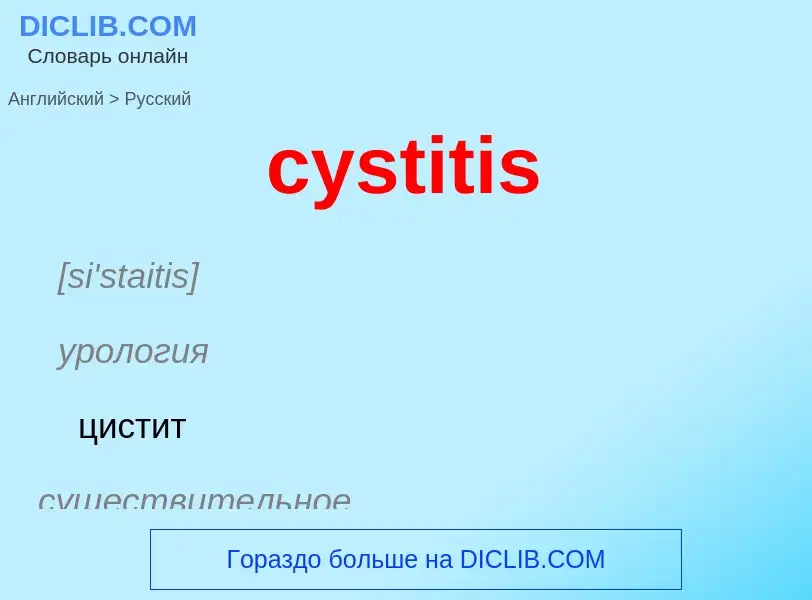Vertaling en analyse van woorden door kunstmatige intelligentie
Op deze pagina kunt u een gedetailleerde analyse krijgen van een woord of zin, geproduceerd met behulp van de beste kunstmatige intelligentietechnologie tot nu toe:
- hoe het woord wordt gebruikt
- gebruiksfrequentie
- het wordt vaker gebruikt in mondelinge of schriftelijke toespraken
- opties voor woordvertaling
- Gebruiksvoorbeelden (meerdere zinnen met vertaling)
- etymologie
cystitis - vertaling naar russisch
[si'staitis]
урология
цистит
существительное
медицина
воспаление мочевого пузыря
цистит
воспаление мочевого пузыря, цистит
медицина
острый цистит
Definitie
Wikipedia
A urinary tract infection (UTI) is an infection that affects part of the urinary tract. When it affects the lower urinary tract it is known as a bladder infection (cystitis) and when it affects the upper urinary tract it is known as a kidney infection (pyelonephritis). Symptoms from a lower urinary tract infection include pain with urination, frequent urination, and feeling the need to urinate despite having an empty bladder. Symptoms of a kidney infection include fever and flank pain usually in addition to the symptoms of a lower UTI. Rarely the urine may appear bloody. In the very old and the very young, symptoms may be vague or non-specific.
The most common cause of infection is Escherichia coli, though other bacteria or fungi may sometimes be the cause. Risk factors include female anatomy, sexual intercourse, diabetes, obesity, and family history. Although sexual intercourse is a risk factor, UTIs are not classified as sexually transmitted infections (STIs). Kidney infection, if it occurs, usually follows a bladder infection but may also result from a blood-borne infection. Diagnosis in young healthy women can be based on symptoms alone. In those with vague symptoms, diagnosis can be difficult because bacteria may be present without there being an infection. In complicated cases or if treatment fails, a urine culture may be useful.
In uncomplicated cases, UTIs are treated with a short course of antibiotics such as nitrofurantoin or trimethoprim/sulfamethoxazole. Resistance to many of the antibiotics used to treat this condition is increasing. In complicated cases, a longer course or intravenous antibiotics may be needed. If symptoms do not improve in two or three days, further diagnostic testing may be needed. Phenazopyridine may help with symptoms. In those who have bacteria or white blood cells in their urine but have no symptoms, antibiotics are generally not needed, although during pregnancy is an exception. In those with frequent infections, a short course of antibiotics may be taken as soon as symptoms begin or long-term antibiotics may be used as a preventive measure.
About 150 million people develop a urinary tract infection in a given year. They are more common in women than men, but similar between anatomies while carrying indwelling catheters. In women, they are the most common form of bacterial infection. Up to 10% of women have a urinary tract infection in a given year, and half of women have at least one infection at some point in their lifetime. They occur most frequently between the ages of 16 and 35 years. Recurrences are common. Urinary tract infections have been described since ancient times with the first documented description in the Ebers Papyrus dated to c. 1550 BC.


![Uropathogenic ''Escherichia coli'' (UPEC)]] cells adhered to bladder epithelial cell Uropathogenic ''Escherichia coli'' (UPEC)]] cells adhered to bladder epithelial cell](https://commons.wikimedia.org/wiki/Special:FilePath/UPEC adhered to BEC.jpg?width=200)
